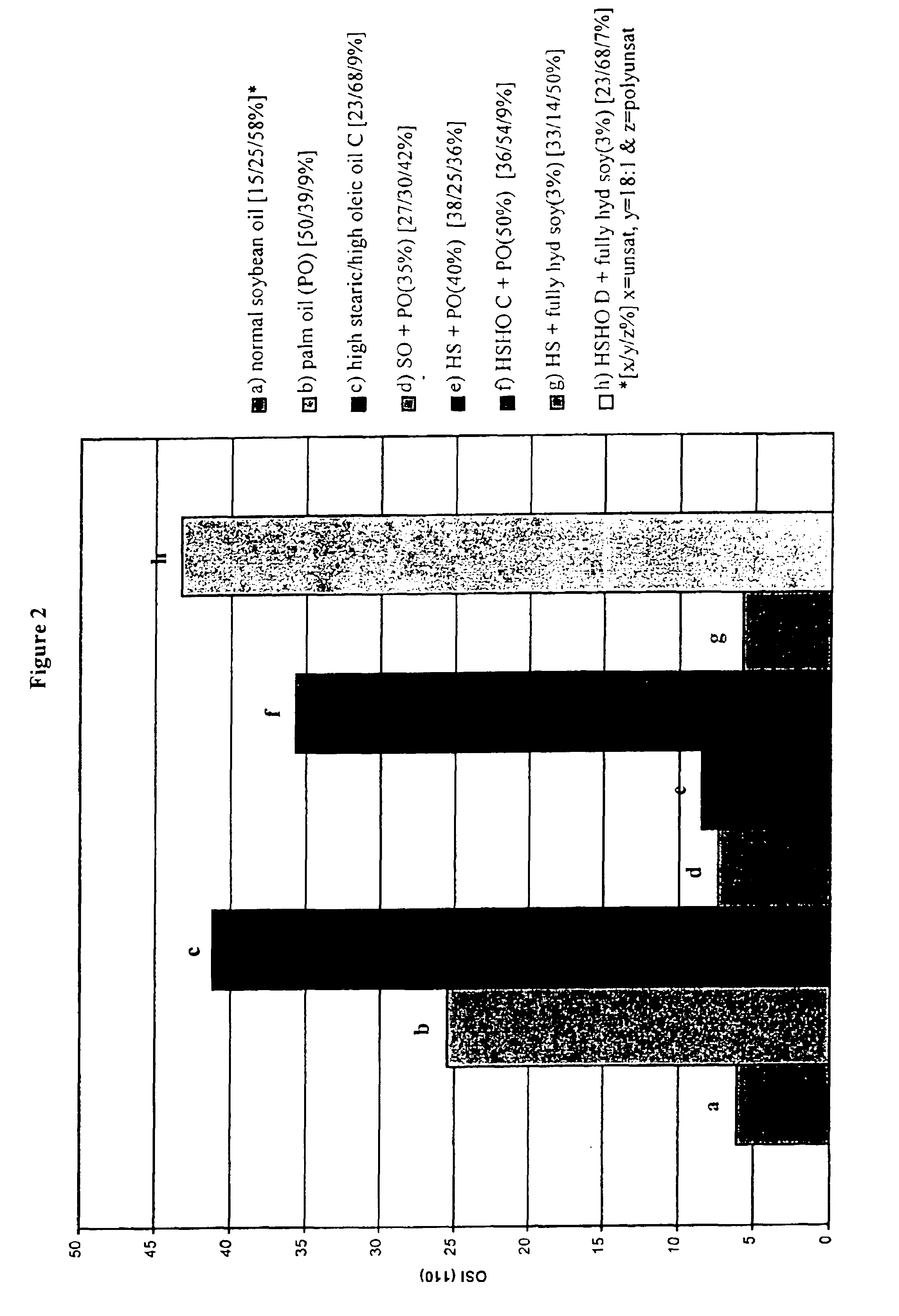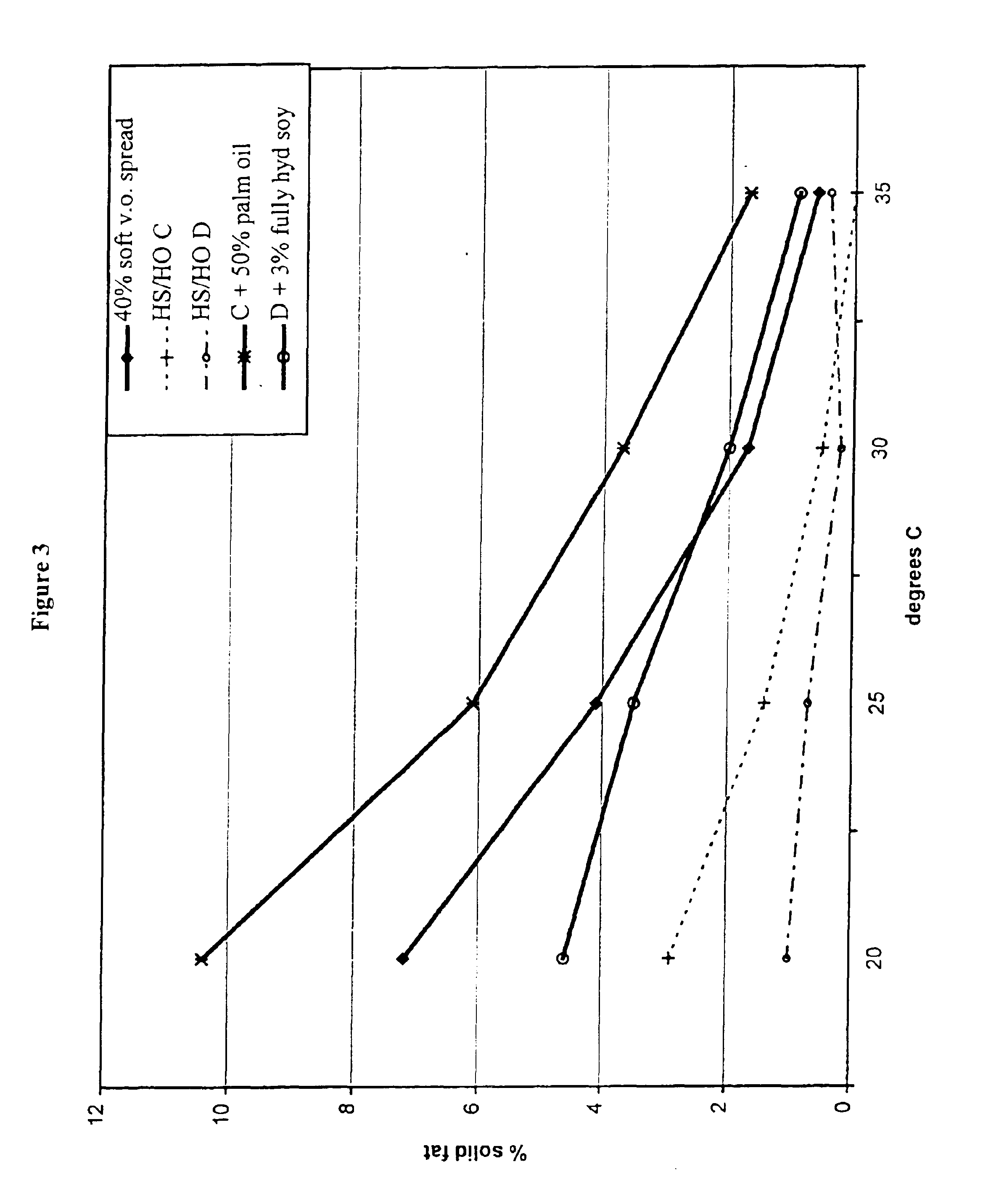Gene combinations that alter the quality and functionality of soybean oil
a technology of soybean oil and gene combinations, applied in the field of new gene combinations, can solve the problems of unstable oil, prone to unpleasant odors and flavors, and reduced polyunsaturated fats,
- Summary
- Abstract
- Description
- Claims
- Application Information
AI Technical Summary
Benefits of technology
Problems solved by technology
Method used
Image
Examples
example 1
Preparation of Oils from Soybeans and Analyses of Fatty Acid Compositions
[0116]All of the oils used in these examples were prepared according to the following laboratory scale method. Harvested soybeans were heated in the microwave to 180° F., cooled to room temperature and cracked using a Roskamp TRC 650-6 Crack and Roll. Soybean hulls were removed using a Kice Aspirator and the remaining meats were heated to 180° F. and flaked in a Roskamp TRC 912 Flake and Roll. Crude oil was extracted in a glass, water-jacketed extraction vessel heated to 60° for 45 minutes using a solvent to solids ratio of approximately 4:1. The hexane / oil miscella was collected and the extraction repeated. The miscella was desolventized using a rotary evaporator leaving crude oil.
[0117]A volume of an 85% phosphoric acid solution equal to 0.1% (v / v) of the crude oil was added and the solution heated to 65°-70° for 10 minutes while stirring. Warm (60°) NaOH (8% aqueous solution) was added dropwise to the oil to...
example 2
Solid Fat Content of Commercial Margarine
[0122]Samples of commercial margarine with varying degrees of solidity were analyzed for SFC. Samples were prepared by melting the product at 100 degrees and removing the aqueous layer. The resulting fat fraction was analyzed for SFC as a function of temperature and the results are listed in Table 4. The table shows the range of solids which can be used to produce different types of margarine and spread products depending on the fat plasticity and the product form desired (e.g., soft tub, stick, low fat spread).
[0123]
TABLE 4Solid fat content of commercial margarine at various temperaturesFunctionalityProduct Form1015202530354068% vegetable oil spreadstick24.223.516.28.54.10.90.540% vegetable oil spreadstick22.221.71583.61.10.070% corn oil spreadstick31.025.817.610.950.70.140% vegetable oil spreadsoft tub16.411.97.24.11.70.60.324% vegetable oil spreadsoft tub18.513.99.45.83.31.30.670% vegetable oil spreadstick40.332.122.712.65.11.30.1corn oil ...
example 3
Solid Fat Content of a High Stearic Soybean Oils
[0124]High stearic acid soybeans from the line designated L9216116-109 were developed at DuPont from a pedigree (HST1*(HO2*HO4))*A2506 (which means the progeny from a cross between HO2 and HO4, was crossed to HST1, and the resulting progeny was crossed to a wild-type line, A2506 to produce L9216116-109). The seeds produced have a higher stearic acid content and lower linolenic acid content than conventional soybeans. The parents HST1, HO2, and HO4 (see Table 2) are mutant lines selected by the mutagenesis protocols outlined in U.S. Pat. No. 5,710,365, except different soybean lines were used as starting materials for the mutagenesis, and selection was based on variation in fatty acid content instead of carbohydrate content. HST1 is a mutant of line N85-2176 which is a high oleic, low linolenic line developed at North Carolina State University by J. W. Burton (Kuhr et al., Mar. 26, 1987 Release Notice for N85-2124, N85-2131, and N85-217...
PUM
| Property | Measurement | Unit |
|---|---|---|
| melting point | aaaaa | aaaaa |
| temperatures | aaaaa | aaaaa |
| temperatures | aaaaa | aaaaa |
Abstract
Description
Claims
Application Information
 Login to View More
Login to View More - R&D
- Intellectual Property
- Life Sciences
- Materials
- Tech Scout
- Unparalleled Data Quality
- Higher Quality Content
- 60% Fewer Hallucinations
Browse by: Latest US Patents, China's latest patents, Technical Efficacy Thesaurus, Application Domain, Technology Topic, Popular Technical Reports.
© 2025 PatSnap. All rights reserved.Legal|Privacy policy|Modern Slavery Act Transparency Statement|Sitemap|About US| Contact US: help@patsnap.com



